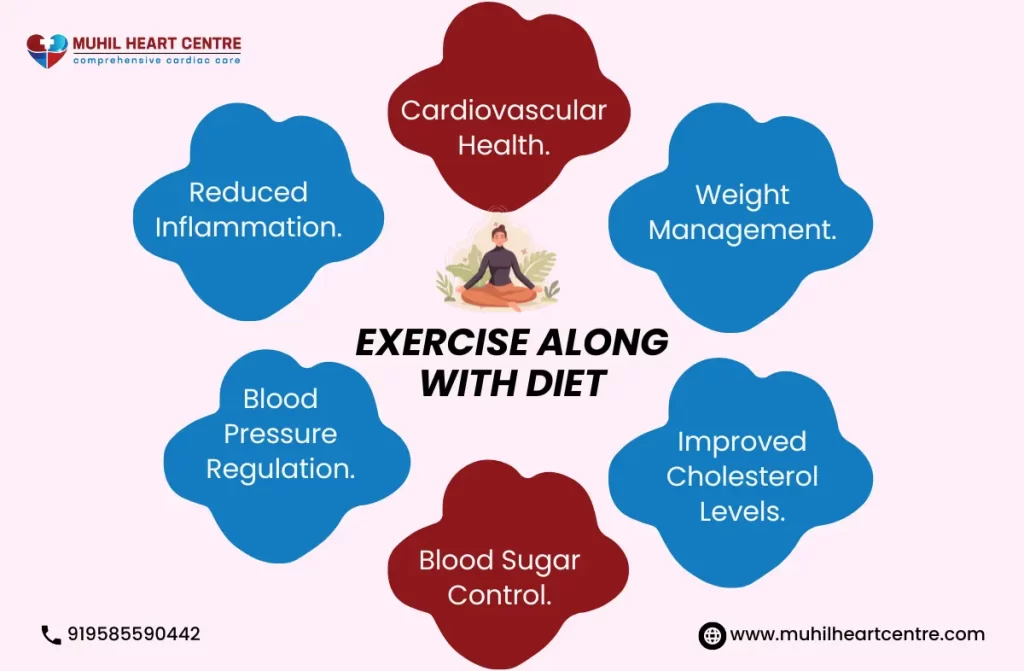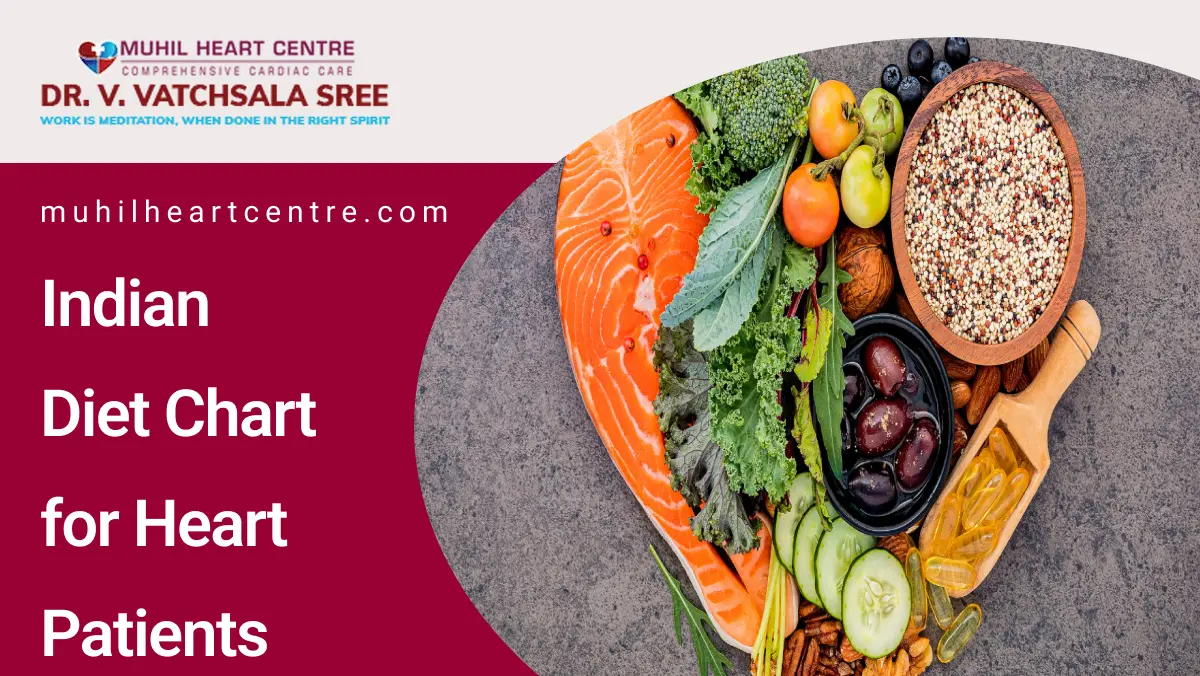A balanced and heart-healthy diet plays a pivotal role in managing and preventing heart diseases. For individuals, where a variety of flavorful and nutritious foods are readily available, crafting an Indian diet chart for heart patients promotes heart health making it both feasible and delicious. In this blog post, we’ll provide you with an insightful Indian diet chart tailored specifically for heart patients, along with essential dietary tips to ensure a healthier heart.
Understanding the Basics
- Limit Saturated and Trans Fats:
- Avoid or minimize consumption of fried foods, processed snacks, and fatty cuts of meat.
- Choose healthier cooking techniques like grilling, steaming, and baking.
- Replace saturated fats with heart-healthy fats from sources such as nuts, seeds, and olive oil while considering an Indian diet chart for heart patients.
- Incorporate Lean Protein:
- Choose lean sources of protein like fish, skinless poultry, legumes, and low-fat dairy products.
- These sources provide essential nutrients without the excess saturated fat found in red meats.
- Include Whole Grains:
- Replace refined grains with whole grains like brown rice, whole wheat, oats, and millets.
- Whole grains can be included in an Indian diet chart for heart patients as they are rich in fiber, aiding digestion and maintaining steady blood sugar levels.
- Embrace Plant-Based Foods:
- Load up on a variety of fruits and vegetables, as they are packed with antioxidants, vitamins, and minerals.
- These foods in the Indian diet plan for heart patients contribute to overall heart health by reducing inflammation and improving blood vessel function.

A 7-Day Indian Diet Chart for Heart Patients
This Indian diet chart for heart patients supports cardiovascular health and manages risk factors.
Day 1
- Breakfast: Oatmeal with chopped fruits and nuts.
- Lunch: Grilled chicken or paneer salad with mixed greens.
- Snack: Carrot sticks with hummus can be included in the Indian diet chart for angioplasty patients.
- Dinner: Lentil soup (dal) with brown rice and a side of vegetable curry.
Day 2
- Breakfast: Whole wheat toast with scrambled egg whites and tomato slices.
- Lunch: Quinoa and vegetable stir-fry.
- Snack: Mixed nuts and seeds.
- Dinner: Grilled fish along with quinoa or/and steamed broccoli.
Day 3
- Breakfast: Greek yogurt with berries and a sprinkle of flaxseeds.
- Lunch: Chickpea curry (chana masala) with whole wheat roti.
- Snack: Roasted chickpeas.
- Dinner: Vegetable and tofu stir-fry with brown rice plays a significant role in the Indian diet plan for heart patients.
Day 4
- Breakfast: Pancake or moong dal chilla with mint chutney.
- Lunch: Brown rice with spinach and mushroom curry.
- Snack: Fresh fruit salad also can be included as a healthy snack in the Indian diet plan for heart patients.
- Dinner: Lentil soup (dal) with quinoa and a side of roasted vegetables.
Day 5
- Breakfast: Whole grain upma with vegetables.
- Lunch: Tofu wrap or grilled chicken with whole wheat tortilla.
- Snack: Cottage cheese (paneer) cubes.
- Dinner: Baked sweet potato with black bean topping.
Day 6
- Breakfast: Idli with coconut chutney and sambar.
- Lunch: Mixed vegetable pulao with raita.
- Snack: Almonds and walnuts play a crucial role in the Indian diet chart for angioplasty patients.
- Dinner: Stuffed bell peppers with quinoa and lean ground turkey.
Day 7
- Breakfast: Poha (flattened rice) with peanuts and peas.
- Lunch: Whole wheat pasta with tomato and basil sauce.
- Snack: Roasted pumpkin seeds.
- Dinner: Tofu tikka masala with brown rice.
Important Tips
An individual who follows this Indian diet chart for heart patients should also ensure to follow these below tips:
- Stay hydrated by intaking more water, fresh fruit juices, and herbal teas.
- Limit sodium intake by avoiding processed foods or excessive salt.
- Control portion sizes to avoid overeating.
- Monitor cholesterol levels and follow your doctor’s recommendations after following the Indian diet chart for angioplasty patients.
- Engage in physical activity routinely to complement your diet.
7 Day Sample Meal Plan For Heart
Day 1:
Breakfast: Oatmeal with sliced strawberries and a sprinkle of chia seeds.
lunch: savor a salad featuring grilled chicken atop a medley of mixed greens, cherry tomatoes, and cucumber, all drizzled with a delightful vinaigrette dressing.
Dinner: Baked salmon, quinoa, and steamed broccoli.
Day 2:
Breakfast: Greek yogurt parfait with blueberries, almonds, and a drizzle of honey.
Lunch: Whole grain wrap with turkey, spinach, tomatoes, and mustard.
Dinner: Lentil soup, mixed green salad, and a small whole-grain roll.
Day 3:
Breakfast: enjoy a serving of whole grain toast topped with creamy avocado and perfectly poached eggs.
Lunch: Quinoa salad with black beans, corn, cherry tomatoes, and a lime vinaigrette.
Dinner: Grilled shrimp, brown rice, and roasted Brussels sprouts.
Day 4:
Breakfast: Smoothie with spinach, banana, berries, Greek yogurt, and a splash of almond milk.
Lunch: Chickpea and vegetable stir-fry with brown rice.
Dinner: Baked chicken breast, sweet potato wedges, and sautéed green beans.
Day 5:
Breakfast: Whole grain cereal with skim milk and sliced peaches.
Lunch: Quinoa and vegetable-stuffed bell peppers.
Dinner: Baked cod, quinoa pilaf, and steamed asparagus.
Day 6:
Breakfast: Start your day with whole grain pancakes topped with fresh berries and a generous scoop of Greek yogurt.
Lunch: Lentil and vegetable soup with a side of whole-grain crackers.
Dinner: Grilled turkey burger with a whole-grain bun, lettuce, and tomato.
Day 7:
Breakfast: Vegetable omelet with whole grain toast.
Lunch: Spinach and feta salad with grilled chicken, cherry tomatoes, and balsamic vinaigrette.
Dinner: Baked tilapia, quinoa salad with diced vegetables, and steamed broccoli.
Conclusion
To conclude, the Indian diet chart for heart patients doesn’t have to be bland or restrictive. By making smart food choices and incorporating a variety of nutrient-rich options, you can promote heart health while savoring the vibrant flavors of Indian cuisine. Remember, consulting with a healthcare professional or registered dietitian at the best cardiac clinics in Vellore like Muhil Heart Centre is crucial to tailor your diet according to your individual health needs.
Read also Heart Bypass Surgery in Vellore.


